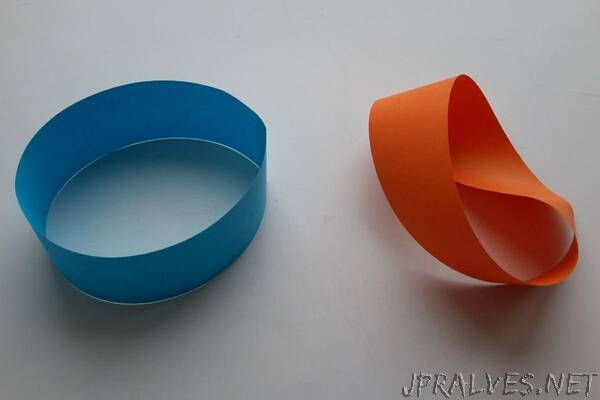
“An international group of scientists, including Alexey Soluyanov, Senior Research Associate at St Petersburg University, have proved the existence of new topological phases of metals which lie outside any previously developed classifications.
The results of the research have been published in one of the most prestigious scientific journals worldwide – Science. They answer some of the fundamental questions in physics and might be found useful in developing a quantum computer.
In order to understand what a topological phase is, it might be useful to recall the Moebius band, which you probably remember from the school programme. If you take a paper strip and join its ends, you will get a ring. However, if you take a paper strip, give it a half twist and then join its ends, you will get a Moebius band. You can twist the strip several times, and then after gluing its ends the figures which you create will have a different number of band twists. Without cutting the band not all of them can become identical. In other words, they are topologically different. The quantum state of a one-dimensional crystal system can also be visualised as a band: it can be described by a periodic wave function, and presented as a vector at each point of a ring, or as a section of a band.
Scientists from all around the world are actively studying the various topological phases of matter. It is possible to observe some of them in laboratory experiments, while the existence of others is predicted only in theory. Phases may generally be detected at low temperatures. The goal of the majority of the research is to compete the classification of all possible phases of matter. This will enable testing of complex fundamental quantum theories in crystals of already known substances. It will open the way to developing new materials with unique properties. A research group of theoretical physicists from the École Polytechnique Fédérale de Lausanne (Switzerland), the University of Zurich (Switzerland), Stanford University (USA) and St Petersburg University have made a significant contribution to achieving this goal.
Standard classification of topological phases of crystalline solids in our work is called the ten-fold way. It is based on discrete symmetries in crystals. Inclusion of crystalline symmetries into classification generally leads to realisation of topological states similar to those described in the ten-fold way. Our research, however, proves that there is a possibility to discover absolutely new topological states when there exists a specific crystalline symmetry.
Alexey Soluyanov, Senior Research Associate of St Petersburg University
Based on their calculations with Scandium, the scientists predicted the existence of new topological phases, which had not been previously described in classifications. The next step for the physicists will be the theoretical study of these materials as they might potentially have unique properties.
The results obtained, according to Alexey Soluyanov, might prove useful for modelling a quantum processor – a hypothetical powerful computing machine that operates according to the laws of quantum world. He noted that the slightest excitation of a quantum computer system, such as a change in temperature, might destroy all the data that was stored. The study of topological phases might help to identify an energy gap, or certain limits, within which external excitation will not affect the information.
‘This work also illustrates how the physics of simple crystalline systems might help in addressing fundamental challenges,’ said Alexey Soluyanov. ‘As crystalline materials do not have strong interactions between electrons, it is possible to apply to them simple physical theories. The research of the last decade demonstrated that there are excitations in the matter that are analogous to elementary particles. It enables us to make simulations and solve tasks in the field of elementary particle physics and gravitational physics. The main challenge now is to identify correct analogies.’”
